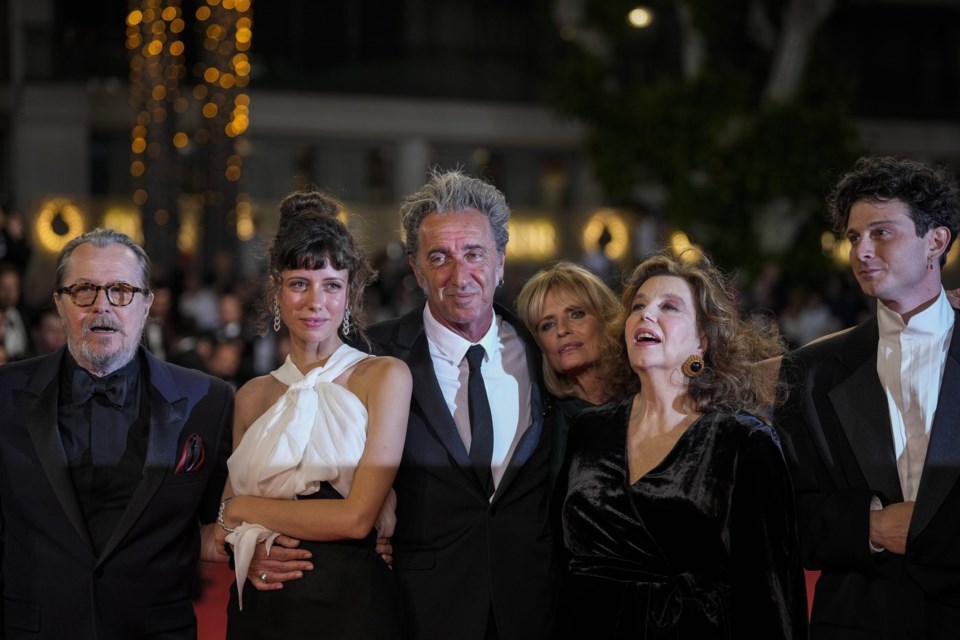ROME (AP) — When director Paolo Sorrentino’s hit series debuted in 2016, it took the Vatican a year to grudgingly bless his imagined and occasionally blasphemous portrayal of the pope. Not so for Sorrentino’s latest film “Parthenope,” which has gotten an early thumbs down from Italy's Catholic Church.
That has only seemed to pique interest in the film, driving it to the top of the box office here for Italian films since its release in theaters last month.
Set in Sorrentino’s native Naples, the film is a lush meditation on beauty, love and death, drawn from the Greek myth of the siren Parthenope, who throws herself into the sea after she fails to entice Odysseus with her song. Parthenope is closely affiliated with Naples, such that the city is sometimes called “Partenope” and its people “Partenopei” in Italian.
The film is by no means about the church, but toward the end of the film, there is a single scene that would make any Catholic choke. It involves a cardinal, the seductive protagonist Parthenope and the liquification of the blood of San Gennaro — the purported recurring miracle that is a sacred cow to many Neapolitans.
Prominent Italian Catholics have denounced the sacrilegious sex scene as not only demeaning to the faith but Naples itself, with the newspaper of the Italian bishops conference Avvenire calling the “sterile aesthetics” of the scene “in poor taste.”
In a roundup of negative reaction, Avvenire said Sorrentino’s fascination with the Catholic Church in “The Young Pope” had reached new lows in “Parthenope.”
“The impression is that they are images chosen for the image, whether nuns playing tennis or cardinals smoking cigars,” Avvenire concluded.
Monsignor Vincenzo De Gregorio, who oversees the chapel that houses the relic of San Gennaro’s blood and related treasures of Naples’ patron saint, said he hadn’t seen the film in its entirety but that the clips of the scene were enough.
While acknowledging that his comments would only give the film more publicity, De Gregorio told Corriere della Sera that he objected primarily to the “superficial” treatment the film gave to one of Naples’ enduring mysteries: How San Gennaro’s blood liquifies, or doesn’t, on three specific days each year.
According to legend, the purported miracle recalls the eruption of Mt. Vesuvius in 1631 when the blood of San Gennaro liquified and the magma from the volcano stopped before entering the city. San Gennaro is today often invoked to protect Neapolitans, and the thrice-yearly ritual draws thousands of devotees.
“Of course Sorrentino didn’t intend to make a documentary or an in-depth, sociological, historical analysis of Naples, but simply to analyze its dreamlike aspect, because basically that’s all it is,” De Gregorio told Corriere.
Sorrentino, who won an Oscar for his Fellini-esque love letter to Rome, has said his ode to Naples had to focus on Parthenope, the sea and the complicated and at times contradictory relationship between them and Naples itself.
“She is a free woman, very spontaneous, she doesn’t judge, as the city doesn’t judge,” he told a press conference at the Cannes Film Festival, where “Parthenope” debuted in May to a standing ovation. “She’s the mirror of the city where I grew up.”
And some have hailed “Parthenope,” with the Cannes jury giving its cinematographer, Daria d’Antonio, the festival's technical award. This week, Italian media reported that T-shirts have begun circulating around Naples with “I love Sorrentino” and “I love Parthenope,” and new figurines for Christmas creches, for which Neapolitan artisans are famous, featuring one of the film’s characters.
Sorrentino himself found adoring fans seeking selfies and autographs this week during a special screening of the film in Palermo, Sicily.
It's the latest brush of recent cinematic attention for Naples, the backdrop for the HBO television series “My Brilliant Friend” based on the best-selling quartet of novels by Elena Ferrante.
Sorrentino’s last feature film, was also based in Naples and featured another sacred but secular icon to Neapolitans, Maradona. Before that, he made a splash with his 10-episode series “The Young Pope,” starring Jude Law as an improbable and controversial pope, which was followed by “The New Pope,” starring John Malkovich.
A year after the initial HBO and Sky series began airing in Italy in late 2016, the Vatican newspaper L’Osservatore Romano finally offered generally positive reviews despite what it called the “frivolous,” ’’caustic” and “grotesque” way it painted the Vatican.
L’Osservatore Romano hasn’t commented on “Parthenope.”
The Vatican is a perennial topic for directors, with a host of films in recent years focusing on the papacy including Nanni Moretti’s “Habemus Papam,” Netflix’s “The Two Popes” and most recently “Conclave” starring Ralph Fiennes.
___
Associated Press religion coverage receives support through the AP’s with The Conversation US, with funding from Lilly Endowment Inc. The AP is solely responsible for this content.
Nicole Winfield, The Associated Press



